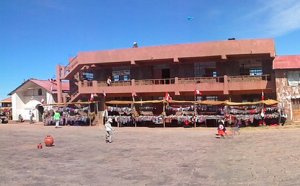
Peru climate zones
 Peru is amongst the larger Southern United states nations - some ten times the dimensions of England - addressing a location of just one, 285, 000 square kilometres with a population of over 26 million. Around seventy percent of their residents live in urban centers, which are mainly located along the coast and restricted very nearly exclusively to six thin but relatively fertile river valleys working into the Pacific.
Peru is amongst the larger Southern United states nations - some ten times the dimensions of England - addressing a location of just one, 285, 000 square kilometres with a population of over 26 million. Around seventy percent of their residents live in urban centers, which are mainly located along the coast and restricted very nearly exclusively to six thin but relatively fertile river valleys working into the Pacific.
Peru is unique in possessing these types of numerous ecosystems ranging from the dryest hot wilderness in the Americas, toward high Andean peaks (over 7600m above sea level); from a-two- thousand-kilometre-long belt of cloud forest, high in flora and fauna, to an enormous section of lowland Amazon forest, covering approximately half the united states. The 3 primary zones of Peru tend to be generally La Costa (the coastline), La Sierra (the mountains) and La Selva (the forest). Within a matter of hours, you can easily keep the scorching desert coastline with some associated with Pacific Ocean's most readily useful fishing, cross the world's highest tropical mountain range - the Andes - and leap down into the planet's biggest tropical rainforest.
 The strange climate in Peru are manufactured primarily by two major offshore ocean currents - the cold Humbolt Current approaching from Chile while the Antarctic, which fulfills the hot, tropical El Niño current decreasing through the Pacific along the Ecuadorian shore. The Humbolt is essentially accountable for the dry wilderness shoreline of Peru and Northern Chile, sending Pacific clouds up to the Andes in which they precipitate as rain. Traditional Peruvian wisdom says it just really rains on the Peruvian coastline about when every 20 years roughly, when the El Niño present pushes further along the coastline, heating the seas and causing troublesome rains in desert. These rains bring damaging floods to towns and settlements defectively prepared for torrential downpours and often inhabited by migrants from hills. But the rains additionally bring the wilderness into bloom as all the crazy flower seeds, preserved because of the drought conditions, suddenly burst into life. Over the past couple of years, the Peruvian weather condition has-been rather unsettled and El Niño has been acting more unpredictably than normal, possibly as a result of international warming. But however hardly ever rains from the coastline, even though Lima area does experience substantial smog, seaside fogs or mists as well as drizzle, specifically involving the months of May and November.
The strange climate in Peru are manufactured primarily by two major offshore ocean currents - the cold Humbolt Current approaching from Chile while the Antarctic, which fulfills the hot, tropical El Niño current decreasing through the Pacific along the Ecuadorian shore. The Humbolt is essentially accountable for the dry wilderness shoreline of Peru and Northern Chile, sending Pacific clouds up to the Andes in which they precipitate as rain. Traditional Peruvian wisdom says it just really rains on the Peruvian coastline about when every 20 years roughly, when the El Niño present pushes further along the coastline, heating the seas and causing troublesome rains in desert. These rains bring damaging floods to towns and settlements defectively prepared for torrential downpours and often inhabited by migrants from hills. But the rains additionally bring the wilderness into bloom as all the crazy flower seeds, preserved because of the drought conditions, suddenly burst into life. Over the past couple of years, the Peruvian weather condition has-been rather unsettled and El Niño has been acting more unpredictably than normal, possibly as a result of international warming. But however hardly ever rains from the coastline, even though Lima area does experience substantial smog, seaside fogs or mists as well as drizzle, specifically involving the months of May and November.
RELATED VIDEO



Share this Post
Related posts
All Inclusive Resorts in Central America
Discover the normal splendour and dazzling surroundings of Central The united states with Signature holidays . Connecting…
Read MorePeru Adventure Tours
One of our most popular destinations in South America, our Peru adventure trips provide an extraordinary selection of experiences…
Read More
 The Yungas is a stretch of forest along the eastern slope of the Andes Mountains from Peru, Bolivia and northern Argentina. It is a transitional zone between the Andean highlands and the eastern forests. Like the surrounding areas, it has characteristics of the...
The Yungas is a stretch of forest along the eastern slope of the Andes Mountains from Peru, Bolivia and northern Argentina. It is a transitional zone between the Andean highlands and the eastern forests. Like the surrounding areas, it has characteristics of the...

